Genesis of the Baiyun Gold Deposit in Northeast Hubei Province, China: Insights from In Situ Trace Elements and S-Fe Isotopes of Sulfide
Abstract
1. Introduction
2. Geological Background
2.1. Regional Geology
2.1.1. Tongbai-Dabie Metallogenic Belt
2.1.2. Baiyun Gold Deposit
2.2. Deposit Geology
3. Samples and Analytical Methods
3.1. Sample Preparation
3.2. LA-ICP-MS Trace Element Analyses
3.3. In Situ S Isotope Analysis
3.4. In Situ Fe Isotope Analysis
4. Results
4.1. Occurrence and Texture of Pyrites
4.1.1. Py1
4.1.2. Py2
4.2. Occurrence and Texture of Galenas
4.2.1. Gn1
4.2.2. Gn2
4.3. Trace Elements of Pyrites Samples Determined Using LA-ICP-MS
4.4. Sulfur Isotope Ratios of Pyrite and Galena Samples
4.5. Iron Isotope Ratios of Pyrite Samples
5. Discussion
5.1. Genesis of Pyrite and Mechanism of Gold Precipitation
5.2. Sources of Sulfur and Iron
5.3. Genesis of the Deposit
6. Conclusions
Author Contributions
Funding
Data Availability Statement
Acknowledgments
Conflicts of Interest
References
- Chen, H.J.; Chen, Y.J.; Zhang, J.; Chen, X.Z.; Zhang, H.D. Zircon U–Pb ages and Hf isotope characteristics of the ore-bearing intrusion from the Shapinggou molybdenumdeposit, Jinzhai County, Anhui Province. Acta Petrol. Sin. 2013, 29, 131–145, (In Chinese with English Abstract). [Google Scholar]
- Chen, Y.J.; Wang, P.; Li, N.; Yang, Y.F.; Pirajno, F. The collision-type porphyry Mo deposits in Dabie Shan, China. Ore Geol. Rev. 2017, 81, 405–430. [Google Scholar] [CrossRef]
- Gao, Y.; Mao, J.W.; Ye, H.S.; Li, Y.F.; Luo, Z.Z.; Yang, Z.Q. Petrogenesis of ore-bearingporphyry from the Tangjiaping porphyry Mo deposit, Dabie orogen: Zircon U–Pb geochronology, geochemistry and Sr–Nd–Hf isotopic constraints. Ore Geol. Rev. 2016, 79, 288–300. [Google Scholar] [CrossRef]
- Mao, J.W.; Xie, G.Q.; Bierlein, F.; Qu, W.J.; Du, A.D.; Ye, H.S.; Pirajno, F.; Li, H.M.; Guo, B.J.; Li, Y.F.; et al. Tectonic implications from Re–Os dating of Mesozoic molybdenum deposits in the East Qinling–Dabie orogenic belt. Geochim. Cosmochim. Acta 2008, 72, 4607–4626. [Google Scholar] [CrossRef]
- Mao, J.W.; Pirajno, F.; Xiang, J.F.; Gao, J.J.; Ye, H.S.; Li, Y.F.; Guo, B.J. Mesozoic molybdenum deposits in the East Qinling–Dabie orogenic belt: Characteristics and tectonic settings. Ore Geol. Rev. 2011, 43, 264–293. [Google Scholar] [CrossRef]
- Mi, M.; Chen, Y.J.; Yang, Y.F.; Wang, P.; Li, F.L.; Wan, S.Q.; Xu, Y.L. Geochronology and geochemistry of the giant Qian’echong Mo deposit, Dabie Shan, eastern China: Implications for ore genesis and tectonic setting. Gondwana Res. 2015, 27, 1217–1235. [Google Scholar] [CrossRef]
- Wang, G.G.; Ni, P.; Yu, W.; Chen, H.; Jiang, L.L.; Wang, B.H.; Zhang, H.D.; Li, P.F. Petrogenesis of Early Cretaceous post-collisional granites at Shapinggou, Dabie Orogen: Implications for crustal architecture and porphyry Mo mineralization. Lithos 2014, 184–187, 393–415. [Google Scholar] [CrossRef]
- Liu, Q.Q.; Li, B.; Shao, Y.J.; Lu, A.H.; Lai, J.Q.; Li, Y.F.; Luo, Z.Z. Molybdenum mineralization related to the Yangtze’s lower crust and differentiation in the Dabie Orogen: Evidence from the geochemical features of the Yaochong porphyry Mo deposit. Lithos 2017, 282–283, 111–127. [Google Scholar] [CrossRef]
- Chen, H.J.; Chen, Y.J. Zircon U-Pb ages and Hf isotope characteristics of granitic rocks from the Shapinggou molybdenum deposit, Dabie Shan, China. Ore Geol. Rev. 2022, 150, 105–151. [Google Scholar] [CrossRef]
- Li, J.Z.; Xiao, Y.P. Preliminary researches on geological characteristics and genesis of Baiyun gold deposit. Huibei Geol. 1990, 4, 32–50, (In Chinese with English Abstract). [Google Scholar]
- Liu, T.F. Geological characteristics and genesis of Baiyun gold deposit, Northeastern Hubei. Gold Geol. 1997, 3, 31–37, (In Chinese with English Abstract). [Google Scholar]
- Xu, X.J.; Zou, Y.B.; Jiang, Z.F.; Meng, Z.P.; Chen, S.; Fang, J. Geological characteristics and genesis analysis of Dapoding gold deposit in northeast Hubei. Gold 2020, 41, 26–31, (In Chinese with English Abstract). [Google Scholar]
- Fan, W.; Xu, X.J.; Wu, C.X.; Li, J.; Meng, Z.P.; Yang, N.H.; Li, B.B. Geological Characteristics and Metallogenic Model of Baiyun Gold Deposit in Dawu County, Hubei Province. Resour. Environ. Eng. 2020, 34, 13–17, (In Chinese with English Abstract). [Google Scholar]
- Hu, X.L.; Gong, Y.J.; Zeng, G.P.; Zhang, Z.J.; Wang, J.; Yao, S.Z. Multistage pyrite in the Getang sediment-hosted disseminated gold deposit, southwestern Guizhou Province, China: Insights from textures and in situ chemical and sulfur isotopic analyses. Ore Geol. Rev. 2018, 99, 1–16. [Google Scholar] [CrossRef]
- Hu, R.Z.; Su, W.C.; Bi, X.W.; Tu, G.Z.; Hofstra, A.H. Geology and geochemistry of Carlin-type gold deposits in China. Mine. Depos. 2002, 37, 378–392. [Google Scholar]
- Su, W.C.; Heinrich, C.A.; Pettke, T.; Zhang, X.C.; Hu, R.Z.; Xia, B. Sediment-hosted gold deposits in Guizhou, China: Products of wall-rock sulfidation by deep crustal fluids. Econ. Geol. 2009, 104, 73–93. [Google Scholar] [CrossRef]
- Su, W.C.; Hu, R.Z.; Xia, B.; Xia, Y.; Liu, Y.P. Calcite Sm-Nd isochron age of the Shuiyindong Carlin-type gold deposit, Guizhou, China. Chem. Geol. 2009, 258, 269–274. [Google Scholar] [CrossRef]
- Chen, M.H.; Mao, J.W.; Li, C.; Zhang, Z.Q.; Dang, Y. Re-Os isochron ages for arsenopyrite from Carlin-like gold deposits in the Yunnan-Guizhou-Guangxi “golden triangle”, southwestern China. Ore Geol. Rev. 2015, 64, 316–327. [Google Scholar] [CrossRef]
- Su, W.C.; Xia, B.; Zhang, H.T.; Zhang, X.C.; Hu, R.Z. Visible gold in arsenian pyrite at the Shuiyindong Carlin-type gold deposit, Guizhou, China: Implications for the environment and processes of ore formation. Ore Geol. Rev. 2008, 33, 667–679. [Google Scholar] [CrossRef]
- Xie, Z.J.; Xia, Y.; Cline, J.S.; Pribil, M.J.; Koenig, A.; Tan, Q.P.; Wei, D.T.; Wang, Z.P.; Yan, J. Magmatic origin for sediment-hosted Au deposits, Guizhou Province, China: In situ chemistry and sulfur isotope composition of pyrites, Shuiyindong and Jinfeng deposits. Econ. Geol. 2018, 113, 1627–1652. [Google Scholar] [CrossRef]
- Large, R.R.; Maslennikon, V.V.; Robert, F.; Danyushevsky, L.V.; Chang, Z.S. Multistage sedimentary and metamorphic origin of pyrite and gold in the giant Sukhoi Log deposit, Lena gold province Russia. Econ. Geol. 2007, 102, 1233–1267. [Google Scholar] [CrossRef]
- Xie, Z.J.; Xia, Y.; Cline, J.S.; Koenig, A.; Wei, D.T.; Tan, Q.P.; Wang, Z.P. Are there Carlin-type Au deposits in China? A comparison of the Guizhou, China, deposits with Nevada, USA. Rev. Econ. Geol. 2018, 20, 187–233. [Google Scholar]
- Hacker, B.R.; Ratschbacher, L.; Webb, L.; Ireland, T.; Walker, D.; Dong, S.W. U–Pb zircon ages constrain the architecture of the ultrahigh-pressure Qinling–Dabie Orogen, China. Earth Planet. Sci. Lett. 1998, 161, 215–230. [Google Scholar] [CrossRef]
- Hacker, B.R.; Ratshbacher, L.; Webb, L.E.; Ireland, T.R.; Calvert, A.; Dong, S.; Wenk, H.R.; Chateigner, D. Exhumation of ultrahigh-pressure continental crust in eastcentral China: Late Triassic–Early Jurassic tectonic unroofing. J. Geophys. Res. Solid Earth 2000, 105, 13339–13364. [Google Scholar] [CrossRef]
- Li, S.G.; Huang, F.; Nie, Y.H.; Han, W.L.; Long, G.; Li, H.M.; Zhang, S.Q.; Zhang, Z.H. Geochemical and geochronological constraints on the suture location between the North and South China blocks in the Dabie orogen, central China. Phys. Chem. Earth Part A Solid Earth Geod. 2001, 26, 655–672. [Google Scholar] [CrossRef]
- Ma, C.Q.; Ehlers, C.; Xu, C.H.; Li, Z.C.; Yang, K.G. The roots of the Dabieshan ultrahigh pressure metamorphic terrane: Constraints from geochemistry and Nd–Sr isotope systematics. Precambrian Res. 2000, 102, 279–301. [Google Scholar] [CrossRef]
- You, Z.D.; Han, Y.J.; Yang, W.R.; Zhang, Z.M.; Wei, B.Z.; Liu, R. The High-Pressure and Ultra High-Pressure Metamorphic Belt in the East Qinling and Dabie Mountains, China; China University of Geosciences Press: Wuhan, China, 1996; pp. 1–150, (In Chinese with English Abstract). [Google Scholar]
- Peng, S.G. Role and significance of “prospecting nearby the large deposits” theory in exploration practice of Wudang-Tongbai-Dabie metallogenic belt. Resour. Environ. Eng. 2024, 38, 16–25, (In Chinese with English Abstract). [Google Scholar]
- Zhang, H.F.; Gao, S.; Zhong, Z. Geochemical and Sr-Nd-Pb isotopic compositions of Cretaceous granitoids: Constraints on tectonic framework and crustal structure of the Dabieshan ultrahigh-pressure metamorphic belt, China. Chem. Geol. 2002, 186, 281–299. [Google Scholar] [CrossRef]
- Xu, X.C.; Lou, J.W.; Xie, Q.Q.; Xiao, Q.X.; Liang, J.F.; Lu, S.M. Geochronology and tectonic setting of Pb-Zn-Mo deposits and related igneous rocks in the Yinshan region, Jinzhai, Anhui province, China. Ore Geol. Rev. 2011, 43, 132–141. [Google Scholar] [CrossRef]
- Zhang, H.F.; Zhong, Z.Q.; Gao, S.; Zhang, B.R.; Zhang, L.; Hu, S.H.; Hou, Q.Y. Pb and Nd isotopic composition of the Jigongshan granite: Constraints on crustal structure of Tongbaishan in the middle part of the Qinling Tongbai Dabie orogenic belt, Central China. Lithos 2004, 73, 215–227. [Google Scholar] [CrossRef]
- Gao, Y.; Mao, L.W.; Ye, H.S.; Meng, F.; Li, Y.F. A review of the geological characteristics and geodynamic sitting of the late Early Cretaceous molybdenum deposits in the East Qinling-Dabie molybdenum belt, East China. J. Asian Earth Sci. 2015, 108, 81–96. [Google Scholar] [CrossRef]
- Xie, Q.Q.; Xu, X.C.; Li, X.X.; Chen, T.H.; Lu, S.M. Rare earth elements geochemistry of Laowan gold deposit in Henan Province: Trace to source of ore-forming materials. J. Rare Earths 2006, 24, 115–120, (In Chinese with English Abstract). [Google Scholar] [CrossRef]
- Li, F.L. Geological characteristics and metallogenic epoch of Qianechong large-size porphyry Mo deposit at the northern foot of Dabie Mountains Henan Province. Miner. Depos. 2011, 30, 457–468, (In Chinese with English Abstract). [Google Scholar]
- Tang, X.W.; Yang, Z.Q.; Guo, Y.S. The study of fluid inclusion and metallogenic model of Xiaofan copper-molybdenum deposit in Henan Province. Miner. Resour. Geol. 2017, 31, 209–219, (In Chinese with English Abstract). [Google Scholar]
- Zhang, H.D.; Wang, B.H.; Hao, Y.J.; Cheng, S.; Xiang, B. Geological characteristics and comprehensive ore-prospecting information of Shapinggou porphyry-type molybdenum deposit in Anhui Province. Miner. Depos. 2012, 31, 41–51, (In Chinese with English Abstract). [Google Scholar]
- Zou, Y.B.; Liu, X.P.; Fan, W.; Li, J.; Cai, L.Y. Geological features and genesis of the Chenlingou gold deposit in Luotian county, Hubei Province. Contrib. Geol. Miner. Resour. Res. 2018, 33, 527–533, (In Chinese with English Abstract). [Google Scholar]
- Zhang, H.D.; Shi, D.F.; Hao, Y.J.; Wang, B.H. Geological features of the Shapinggou porphyry molybdenum ore deposit, Jinzhai County, Anhui Province. Geol. Anhui 2010, 20, 104–108, (In Chinese with English Abstract). [Google Scholar]
- Zhang, H.D.; Wang, G.J.; Shi, D.F. Metallogenic conditions of the Shapinggou porphyry molybdenumore deposit, Jinzhai County, Anhui Province and the prospecting direction. Shanghai Geol. 2010, 31, 203–205, (In Chinese with English Abstract). [Google Scholar]
- Yu, W.; Ni, P.; Wang, G.G.; Shang, L.; Jiang, L.L.; Wang, B.H.; Zhang, H.D. Evolution of ore-forming fluids of the Shapinggou porphyry molybdenum deposit, Jinzhai, Anhui Province. J. Nanjing Univ. 2012, 48, 240–255, (In Chinese with English Abstract). [Google Scholar]
- Zhang, H.; Sun, W.D.; Yang, X.Y.; Liang, H.Y.; Wang, B.H.; Wang, R.L.; Wang, Y.X. Geochronology and metallogenesis of the Shapinggou giant porphyry molybdenum deposit in the Dabie orogenic belt. Acta Geol. Sin. 2011, 85, 2039–2059, (In Chinese with English Abstract). [Google Scholar]
- Zhang, H.D.; Wang, G.J.; Wang, B.H.; Hao, Y.J.; Xiang, B.; Peng, H.H. Shapinggou porphyry molybdenum ore-bearing intrusion and its alteration features. Geol. Anhui 2010, 20, 260–266, (In Chinese with English Abstract). [Google Scholar]
- Yang, Z.Q. Geochemistry and tectonic setting of the Tangjiaping Mo-riched granodiorite porphyry in the northern Dabie Mountains. Geol. Rev. 2009, 55, 745–752, (In Chinese with English Abstract). [Google Scholar]
- Wang, Y.X. Ore-forming features of explosion breccia pipe in Gaijing, Yinsha, Jinzhai county, Anhui Province. Geol. Anhui 2006, 13, 180–184, (In Chinese with English Abstract). [Google Scholar]
- Wei, Q.G.; Gao, X.Y.; Zhao, T.P.; Chen, W.; Yang, Y.H. Petrogenesis of Tangjiaping granite porphyry in northern Dabie: Evidence from zircon LA-ICP-MS U-Pb dating and geochemical characteristics. Acta Petrol. Sin. 2010, 26, 1550–1562, (In Chinese with English Abstract). [Google Scholar]
- Xu, X.C.; Lou, J.W.; Lu, S.M.; Xie, Q.Q.; Chu, P.L.; Yin, T. Re-Os ages of molybdenum-lead-zinc polymetallic deposits and Ar-Ar ages of related magmatic rocks in Yinshan area, Jinzhai, Anhui Province. Miner. Depos. 2009, 28, 621–632, (In Chinese with English Abstract). [Google Scholar]
- Ni, P.; Wang, G.G.; Yu, W.; Chen, H.; Jiang, L.L.; Wang, B.H.; Zhang, H.D.; Xu, Y.F. Evidence of fluid inclusions for two stages of fluid boiling in the formation of the giant Shapinggou porphyry Mo deposit, Dabie Orogen, Central China. Ore Geol. Rev. 2015, 65, 1078–1094. [Google Scholar] [CrossRef]
- Wang, B.H.; Zhang, H.D.; Wang, P.; Xu, X.C.; Hao, Y.J. Geological and geochemical characteristics and genesis of magmatic rocks related to porphyry Mo deposits in the Beihuaiyang region. Earth Sci. Front. 2016, 23, 46–62, (In Chinese with English Abstract). [Google Scholar]
- Huang, F.; Wang, D.H.; Wang, C.H.; Chen, Z.H.; Yuan, Z.X.; Liu, X.X. Resources characteristics of molybdenum deposits and their regional metallogeny in China. Acta Geol. Sin. 2014, 88, 2296–2314, (In Chinese with English Abstract). [Google Scholar]
- Dai, B.Z.; Jiang, S.Y.; Wang, X.L. Petrogenesis of the granitic porphyry related to the giant molybdenum deposit in Donggou, Henan Province, China: Constraints from petrogeochemistry, zircon U-Pb chronology and Sr-Nd-Hf isotopes. Acta Petrol. Sin. 2009, 25, 2889–2901, (In Chinese with English Abstract). [Google Scholar]
- Tu, J.H.; You, J.J. Geological characteristics and prospecting direction of the Niangniangding tungsten-beryllium ore deposit in Hubei Province. Acta Petrol. Mineral. 2017, 36, 703–712, (In Chinese with English Abstract). [Google Scholar]
- Zhong, S.Y.; Xiong, Y.L.; Yang, C.; Li, S.T.; Tu, J.H.; Shi, X.B.; Hu, T.P. Occurrence and Genesis of Beryllium Bearing Minerals in Yangxinyan Beryllium Ore Spot in Dawu County. Resour. Environ. Eng. 2020, 34, 518–524, (In Chinese with English Abstract). [Google Scholar]
- Lu, S.M.; Ruan, L.S.; Zhao, L.L.; Wang, B.H.; Zhang, H.D.; Wang, G.G.; Chen, F. Two stages of diagenesis and metallogenesis of Shapinggou molybdenum-lead-zinc ore field in Jinzhai County, Anhui Province. Acta Gelolgical Sin. 2016, 90, 1167–1181, (In Chinese with English Abstract). [Google Scholar]
- Lu, X.X.; Luo, Z.H.; Huang, F.; Liang, T.; Huang, D.F.; Han, N.; Gao, Y. “Small” magma and “big” fluid lead to form large scale deposit and transmagmatic fluid mineralization: Take for example of Mo deposits in eastern Qinling-Dabie mountain metallogenic belt. Acta Petrol. Sin. 2017, 33, 1554–1570, (In Chinese with English Abstract). [Google Scholar]
- Zhu, Z.Y.; Jiang, S.Y.; Ciobanu, C.L.; Yang, T.; Cook, N.J. Sulfur isotope fractionation in pyrite during laser ablation: Implications for laser ablation multiple collector inductively coupled plasma mass spectrometry mapping. Chem. Geol. 2017, 450, 223–234. [Google Scholar] [CrossRef]
- Hu, Z.C.; Zhang, W.; Liu, Y.S.; Gao, S.; Li, M.; Zong, K.Q.; Chen, H.H.; Hu, S.H. “Wave” signal-smoothing and mercury-removing device for laser ablation quadrupole and multiple collector ICPMS analysis: Application to lead isotope analysis. Anal. Chem. 2015, 87, 1152–1157. [Google Scholar] [CrossRef] [PubMed]
- Wilson, S.A.; Ridley, W.I.; Koenig, A.E. Development of sulfide calibration standards for the laser ablation inductively-coupled plasma mass spectrometry technique. J. Anal. At. Spectrom. 2002, 17, 406–409. [Google Scholar] [CrossRef]
- Liu, Y.S.; Hu, Z.C.; Gao, S.; Guenther, D.; Xu, J.; Gao, C.G.; Chen, H.H. In situ analysis of major and trace elements of anhydrous minerals by LA-ICP-MS without applying an internal standard. Chem. Geol. 2008, 257, 34–43. [Google Scholar] [CrossRef]
- Hu, X.L.; Yao, S.Z.; Ding, Z.J.; He, M.C. Early Paleozoic magmatism and metallogeny in Northeast China: A record from the Tongshan porphyry Cu deposit. Miner. Depos. 2017, 52, 85–103. [Google Scholar] [CrossRef]
- Hu, X.L.; Ding, Z.J.; Yao, S.Z.; He, M.C.; Shen, J.; Zhu, B.P.; Chen, B. Geochronology and Sr-Nd-Hf isotopes of the Mesozoic granitoids from the Great Xing’an and Lesser Xing’an ranges: Implications for petrogenesis and tectonic evolution in NE China. Geol. J. 2016, 51, 1–20. [Google Scholar] [CrossRef]
- Chen, L.; Liu, Y.; Li, Y.; Li, Q.L.; Li, X.H. New potential pyrrhotite and pentlandite reference materials for sulfur and iron isotope microanalysis. J. Anal. At. Spectrom. 2021, 36, 1431–1440. [Google Scholar] [CrossRef]
- Chen, L.; Feng, Y.T.; Yu, H.M.; Zhang, W.; Kang, J.T.; Huang, F.; Hu, Z.C.; Li, X.H. Tianyu-Py pyrite: A new natural reference material for micro-beam determination of iron isotopic ratios. J. Anal. At. Spectrom. 2022, 37, 2300–2308. [Google Scholar] [CrossRef]
- Chen, L.; Feng, Y.T.; Yu, H.M.; Li, L.; Ding, X.; Zhang, W.; Kang, J.T.; Li, X.H. Mineralogical and Geochemical Characterization at a Micro-scale of a New Natural Chalcopyrite Reference Material for In-situ Fe Isotopic Ratio Analysis. At. Spectrosc. 2023, 44, 14–23. [Google Scholar] [CrossRef]
- Deditius, A.P.; Utsunomiya, S.; Reich, M.; Kesler, S.E.; Ewing, R.C.; Hough, R.; Walshe, J. Trace metal nanoparticles in pyrite. Ore Geol. Rev. 2011, 42, 32–46. [Google Scholar] [CrossRef]
- Wang, X.W.; Li, Y.X.; An, F. Status and progress on geochemical behavior of iron isotope in magmatichydrothermal system. Miner. Depos. 2023, 42, 1214–1228, (In Chinese with English Abstract). [Google Scholar]
- Reich, M.; Deditius, A.; Chryssoulis, S.; Li, J.W.; Ma, C.Q.; Parada, M.A.; Barra, F.; Mittermayr, F. Pyrite as a record of hydrothermal fluid evolution in a porphyry copper system: A SIMS/EMPA trace element study. Geochim. Cosmochim. Acta. 2013, 104, 42–62. [Google Scholar] [CrossRef]
- Román, N.; Reich, M.; Leisen, M.; Morata, D.; Barra, F.; Deditius, A.P. Geochemical and micro-textural fingerprints of boiling in pyrite. Geochim. Cosmochim. Acta 2019, 246, 60–85. [Google Scholar] [CrossRef]
- Deditius, A.P.; Utsunomiya, S.; Renock, D.; Ewing, R.C.; Ramana, C.V.; Becker UKesler, S.E. A proposed new type of arsenian pyrite: Composition, nanostructure and geological significance. Geochim. Cosmochim. Acta 2008, 72, 2919–2933. [Google Scholar] [CrossRef]
- Large, R.R.; Danyushevsky, L.; Hollit, C.; Maslennikov, V.; Meffre, S.; Gilbert, S.; Bull, S.; Scott, R.; Emsbo, P.; Thomas, H.; et al. Gold and trace element zonation in pyrite using a laser imaging technique: Implications for the timing of gold in orogenic and Carlinstyle sediment-hosted deposits. Econ. Geol. 2009, 104, 635–668. [Google Scholar] [CrossRef]
- Reich, M.; Kesler, S.E.; Utsunomiya, S.; Palenik, C.S.; Chryssoulis, S.L.; Ewing, R.C. Solubility of gold in arsenian pyrite. Geochim. Cosmochim. Acta 2005, 69, 2781–2796. [Google Scholar] [CrossRef]
- Barker, S.L.L.; Hickey, K.A.; Cline, J.S.; Dipple, G.M.; Kilburn, M.R.; Vaughan, J.R.; Longo, A.A. Uncloaking invisible gold: Use of NanoSIMS to evaluate gold, trace elements, and sulfur isotopes in pyrite from carlin-type gold deposits. Econ. Geol. 2009, 104, 897–904. [Google Scholar] [CrossRef]
- Deditius, A.P.; Utsunomiya, S.; Ewing, R.C.; Chryssoulis, S.L.; Venter, D.; Kesler, S.E. Decoupled geochemical behavior of As and Cu in hydrothermal systems. Geology 2009, 37, 707–710. [Google Scholar] [CrossRef]
- Cook, N.J.; Ciobanu, C.L.; Mao, J.W. Textural control on gold distribution in As-free pyrite from the Dongping, Huangtuliang and Hougou gold deposits, North China Craton (Hebei Province, China). Chem. Geol. 2009, 264, 101–121. [Google Scholar] [CrossRef]
- Thomas, H.V.; Large, R.R.; Bull, S.W.; Maslennikov, V.; Berry, R.F.; Fraser, R.; Froud, S.; Moye, R. Pyrite and pyrrhotite textures and composition in sediments, laminated quartz veins, and reefs at Bendigo Gold Mine, Australia: Insights for ore genesis. Econ. Geol. 2011, 106, 1–31. [Google Scholar] [CrossRef]
- Deditius, A.P.; Reich, M.; Kesler, S.E.; Utsunomiya, S.; Chryssoulis, S.L.; Walshe, J.; Ewing, R.C. The coupled geochemistry of Au and As in pyrite from hydrothermal ore deposits. Geochim. Cosmochim. Acta 2014, 140, 644–670. [Google Scholar] [CrossRef]
- Muntean, J.L.; Cline, J.S.; Simon, A.C.; Longo, A.A. Magmatic-hydrothermal origin of Nevada’s Carlin-type gold deposits. Nat. Geosci. 2011, 4, 122–127. [Google Scholar] [CrossRef]
- Gregory, D.D.; Large, R.R.; Bath, A.B.; Steadman, J.A.; Wu, S.; Danyushevsky, L.; Bull, S.W.; Holden, P.; Ireland, T.R. Trace element content of pyrite from the Kapai Slate, St. Ives Gold District, Western Australia. Econ. Geol. 2016, 111, 1297–1320. [Google Scholar] [CrossRef]
- Tardani, D.; Reich, M.; Deditius, A.P.; Chryssoulis, S.; Sánchez-Alfaro, P.; Wrage, J.; Roberts, M.P. Copper-arsenic decoupling in an active geothermal system: A link between pyrite and fluid composition. Geochim. Cosmochim. Acta 2017, 204, 179–204. [Google Scholar] [CrossRef]
- Loftus-Hills, G.; Solomon, M. Cobalt, nickel and selenium in sulphides as indicators of ore genesis. Miner. Depos. 1967, 2, 228–242. [Google Scholar] [CrossRef]
- Clark, C.; Grguric, B.; Mumm, A. Genetic implications of pyrite chemistry from the Palaeoproterozoic Olary Domain and overlying Neoproterozoic Adelaidean sequences, northeastern South Australia. Ore Geol. Rev. 2004, 25, 237–257. [Google Scholar] [CrossRef]
- Migdisov, A.A.; Zezin, D.; Williams-Jones, A.E. An experimental study of cobalt (Ⅱ) complexation in Cl-and H2 S-bearing hydrothermal solutions. Geochim. Cosmochim. Acta 2011, 75, 4065–4079. [Google Scholar] [CrossRef]
- Grant, H.L.J.; Hannington, M.D.; Petersen, S.; Frische, M.; Fuchs, S.H. Constraints on the behavior of trace elements in the activelyforming TAG deposit, Mid-Atlantic Ridge, based on LA-ICP-MS analyses of pyrite. Chem. Geol. 2018, 498, 45–71. [Google Scholar] [CrossRef]
- Keith, M.; Smith, D.J.; Jenkin, G.R.T.; Holwell, D.A.; Dye, M.D. A review of Te and Se systematics in hydrothermal pyrite from precious metal deposits: Insights into ore-forming processes. Ore Geol. Rev. 2018, 96, 269–282. [Google Scholar] [CrossRef]
- Wang, K.X.; Zhai, D.G.; Liu, J.J.; Wu, H. LA-ICP-MS trace element analysis of pyrite from the Dafang gold deposit, South China: Implications for ore genesis. Ore Geol. Rev. 2021, 139, 104507. [Google Scholar] [CrossRef]
- Simon, G.; Huang, H.; Penner-Hahn, J.E.; Kesler, S.E.; Kao, L.S. Oxidation state of gold and arsenic in gold-bearing arsenian pyrite. Am. Mineral. 1999, 84, 1071–1079. [Google Scholar] [CrossRef]
- Campbell, F.A.; Ethier, V.G. Nickel and cobalt in pyrrhotite and pyrite from the Faro and Sullivan orebodies. Can. Mineral. 1984, 22, 503–506. [Google Scholar]
- Bajwah, Z.U.; Seccombe, P.K.; Offler, R. Trace element distribution, Co:Ni ratios and genesis of the Big Cadia iron-copper deposit, New South Wales, Australia. Miner. Depos. 1987, 22, 292–300. [Google Scholar] [CrossRef]
- Koglin, N.; Frimmel, H.E.; Minter, W.E.L.; Brätz, H. Trace-element characteristics of different pyrite types in Mesoarchaean to Palaeoproterozoic placer deposits. Miner. Depos. 2010, 45, 259–280. [Google Scholar] [CrossRef]
- Reich, M.; Simon, A.C.; Deditius, A.; Barra, F.; Chryssoulis, S.; Lagas, G.; Tardani, D.; Knipping, J.; Bilenker, L.; Sánchez-Alfaro, P.; et al. Trace element signature of pyrite from the Los Colorados Iron Oxide-Apatite (IOA) deposit, Chile: A missing link between Andean IOA and Iron Oxide Copper-Gold systems? Econ. Geol. 2016, 111, 743–761. [Google Scholar] [CrossRef]
- Meyer, F.M.; Robb, L.J.; Oberthür, T.; Saager, R.; Stupp, H.D. Cobalt, nickel, and gold in pyrite from primary gold deposits and Witwatersrand reefs. S. Afr. J. Geol. 1990, 93, 70–82. [Google Scholar]
- Ohmoto, H. Systematics of sulfur and carbon isotopes in hydrothermal ore deposits. Econ. Geol. 1972, 67, 551–578. [Google Scholar] [CrossRef]
- Peterson, E.C.; Mavrogenes, J.A. Linking high-grade gold mineralization to earthquake-induced fault-valve processes in the Porgera gold deposit, Papua New Guinea. Geology 2014, 42, 383–386. [Google Scholar] [CrossRef]
- Rye, R.O.; Ohmoto, H. Sulfur and carbon isotopes and ore genesis: A review. Econ. Geol. 1974, 69, 826–842. [Google Scholar] [CrossRef]
- Ohmoto, H. Stable isotope geochemistry of ore deposits. Rev. Mineral. Geochem. 1986, 16, 491–559. [Google Scholar]
- Ohmoto, H.; Goldhaber, M.B. Sulfur and carbon isotopes. In Geochemistry of Hydrothermal ore Deposits, 2nd ed.; Barnes, H.L., Ed.; John Wiley & Sons Inc.: New York, NY, USA, 1997; pp. 517–612. [Google Scholar]
- Seal, R.R. Sulfur isotope geochemistry of sulfide minerals. Rev. Mineral. Geochem. 2006, 61, 633–677. [Google Scholar] [CrossRef]
- Wang, Y.; Zhu, X.K. Fe isotope systematics and its implications in ore deposit geology. Acta Petrol. Sin. 2012, 28, 3638–3654, (In Chinese with English Abstract). [Google Scholar]
- Zhu, X.K. Fe isotope geochemistry of magmatic system. J. Earth Sci. Environ. 2016, 38, 1–10, (In Chinese with English Abstract). [Google Scholar]
- He, Y.S.; Hu, D.P.; Zhu, C.W. Progress of iron isotope geochemistry in geoscience. Earth Sci. Front. 2015, 22, 54–71, (In Chinese with English Abstract). [Google Scholar]
- Hill, P.S.; Schauble, E.A.; Young, E.D. Effects of changing solution chemistry on Fe3+/Fe2+ isotope fractionation in aqueous Fe-Cl solutions. Geochim. Cosmochim. Acta 2001, 74, 6669–6689. [Google Scholar] [CrossRef]
- Polyakov, V.B.; Soultanov, D.M. New data on equilibrium iron isotope fractionation among sulfides: Constraints on mechanisms of sulfide formation in hydrothermal and igneous systems. Geochim. Cosmochim. Acta 2011, 75, 1957–1974. [Google Scholar] [CrossRef]
- Saunier, G.; Pokrovski, G.S.; Poitrasson, F. First experimental determination of iron isotope fractionation between hematite and aqueous solution at hydrothermal conditions. Geochim. Cosmochim. Acta 2011, 75, 6629–6654. [Google Scholar] [CrossRef]
- Syverson, D.D.; Borrok, D.M.; Seyfried, W.E. Experimental determination of equilibrium Fe isotopic fractionation between pyrite and dissolved Fe under hydrothermal conditions. Geochim. Cosmochim. Acta 2013, 122, 170–183. [Google Scholar] [CrossRef]
- Syverson, D.D.; Luhmann, A.J.; Tan, C.Y.; Borrok, D.M.; Ding, K.; Seyfried, W.E. Fe isotope fractionation between chalcopyrite and dissolved Fe during hydrothermal recrystallization: An experimental study at 350 °C and 500 bars. Geochim. Cosmochim. Acta 2017, 200, 87–109. [Google Scholar] [CrossRef]
- Wu, H.J.; He, Y.S.; Bao, L.E.; Zhu, C.W.; Li, S.G. Mineral composition control on inter-mineral iron isotopic fractionation in granitoids. Geochim. Cosmochim. Acta 2017, 198, 208–217. [Google Scholar] [CrossRef]
- Beard, B.L.; Johnson, C.M.; Skulan, J.L.; Nealson, K.H.; Sun, H. Application of Fe isotopes to tracing the geochemical and biological cycling of Fe. Chem. Geol. 2003, 195, 87–117. [Google Scholar] [CrossRef]
- Rouxel, O.; Toner, B.; Germain, Y.; Glazer, B. Geochemical and iron isotopic insights into hydrothermal iron oxyhydroxide deposit formation at Loihi Seamount. Geochim. Cosmochim. Acta 2018, 220, 449–482. [Google Scholar] [CrossRef]
- Zhu, X.K.; O’nions, R.K.; Guo, Y.L.; Reynolds, B.C. Secular variation of iron isotopes in North Atlantic deep water. Science 2000, 287, 2000–2002. [Google Scholar] [CrossRef] [PubMed]
- Xiang, L.; Schoepfer, S.D.; Zhang, H.; Chen, Z.W.; Cao, C.Q.; Shen, S.Z. Deep-water dissolved iron cycling and reservoir size across the Ediacaran-Cambrian transition. Chem. Geol. 2020, 541, 119575. [Google Scholar] [CrossRef]
- Du, D.H.; Wang, X.L.; Yang, T.; Chen, X.; Li, J.Y.; Li, W.Q. Origin of heavy Fe isotope compositions in high-silica igneous rocks: Arhyolite perspective. Geochim. Cosmochim. Acta 2017, 218, 58–72. [Google Scholar] [CrossRef]
- Li, Q.W.; Zhao, J.H.; Wang, Q.; Zhang, Z.F.; An, Y.J.; He, Y.T. Iron isotope fractionation in hydrous basaltic magmas in deep crustal hot zones. Geochim. Cosmochim. Acta 2020, 279, 29–44. [Google Scholar] [CrossRef]
- Li, W.Q.; Huberty, J.M.; Beard, B.L.; Kita, N.T.; Valley, J.W.; Johnson, C.M. Contrasting behavior of oxygen and iron isotopes in banded iron formations revealed by in situ isotopic analysis. Earth Planet. Sci. Lett. 2013, 384, 132–143. [Google Scholar] [CrossRef]
- Yang, X.Q.; Mao, J.W.; Jiang, Z.S.; Santosh, M.; Zhang, Z.H.; Duan, S.G.; Wang, D.C. The Carboniferous Shikebutai iron deposit in Western Tianshan, Northwestern China: Petrology, Fe-O-C-Si isotopes, and implications for iron pathways. Econ. Geol. 2019, 114, 1207–1222. [Google Scholar] [CrossRef]
- Zhu, X.K.; Sun, J.; Li, Z.H. Iron isotopic variations of the Cryogenian banded iron formations: A new model. Precambrian Res. 2019, 331, 105359. [Google Scholar] [CrossRef]
- Wang, S.J.; Sun, W.D.; Huang, J.; Zhai, S.K.; Li, H.M. Coupled FeS isotope composition of sulfide chimneys dominated by temperature heterogeneity in seafloor hydrothermal systems. Sci. Bull. 2020, 65, 1767–1774. [Google Scholar] [CrossRef] [PubMed]
- Liu, P.P.; Zhou, M.F.; Luais, B.; Cividini, D.; Bard, C.R. Disequilibrium iron isotopic fractionation during the high-temperature magmatic differentiation of the Baima Fe-Ti oxide-bearing mafic intrusion, SW China. Earth Planet. Sci. Lett. 2014, 399, 21–29. [Google Scholar] [CrossRef]
- Ding, X.; Ripley, E.M.; Wang, W.Z.; Li, C.H.; Huang, F. Iron isotope fractionation during sulfide liquid segregation and crystallization at the Lengshuiqing Ni-Cu magmatic sulfide deposit, SW China. Geochim. Cosmochim. Acta 2019, 261, 327–341. [Google Scholar] [CrossRef]
- Wang, Y. Fe and Cu Isotopic Geochemistry in Tongling Ore Concentration Area. Ph.D. Thesis, Chinese Academy of Geological Sciences, Beijing, China, 2011; 128p. (In Chinese with English Abstract). [Google Scholar]
- He, Z.W.; Zhang, X.C.; Deng, X.D.; Hu, H.; Li, Y.; Yu, H.M.; Archer, C.; Li, J.W.; Huang, F. The behavior of Fe and S isotopes in porphyry copper systems: Constraints from the Tongshankou Cu-Mo deposit, eastern China. Geochim. Cosmochim. Acta 2020, 270, 61–83. [Google Scholar] [CrossRef]
- Liu, C.H.; Liu, J.J.; Carranza, M.J.E.; Wang, J.P.; Zhai, D.G.; Zhang, F.F.; Wang, Y.H.; Liu, Z.J. Iron and magnesium isotope systematics from the Shuangwang gold deposit in the Qinling orogen, Central China. Ore Geol. Rev. 2021, 134, 104123. [Google Scholar] [CrossRef]
- Zhang, Y.W.; Fan, H.R.; Hu, F.F.; Liu, X.; Xie, L.W.; Li, X.H. Extreme iron isotope variation of pyrite in the Muping gold deposit, Jiaodong: Implication for tracing metal origin. Ore Geol. Rev. 2021, 139, 104431. [Google Scholar] [CrossRef]
- Cheng, Y.B.; Mao, J.W.; Zhu, X.K.; Wang, Y. Iron isotope fractionation during supergene weathering process and its application to constrain ore genesis in Gaosong deposit, Gejiu district, SW China. Gondwana Res. 2015, 27, 1283–1291. [Google Scholar] [CrossRef]
- Du, D.W.; Ye, C.Z.; Zhang, J.L. Survey Report of Dapoding Gold Deposit, Dawu County, Hubei Province; Northeast Hubei Geological Team: Xiaogan, China, 2008. [Google Scholar]
- Cao, Z.Q.; Xie, Y.B.; Zhou, X.H.; Li, H.L.; Cai, Y.T.; Li, C.K.; Song, H.; Wu, B.; Li, L.J. Origin and ore-controlling structure of the Daleishan gold deposit in Dawu area, Hubei Province. Acta Petrol. Miner. 2017, 36, 733–742, (In Chinese with English Abstract). [Google Scholar]
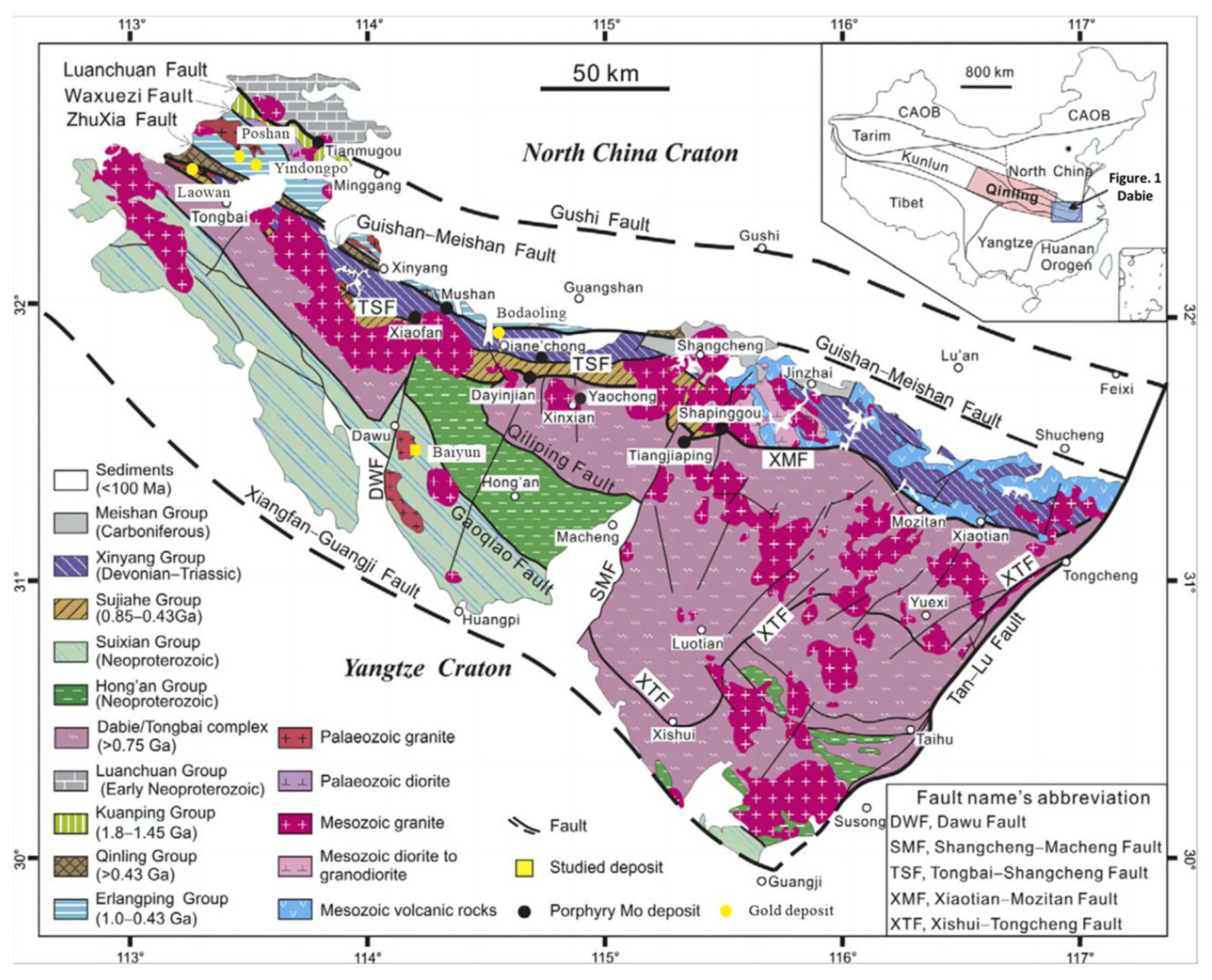
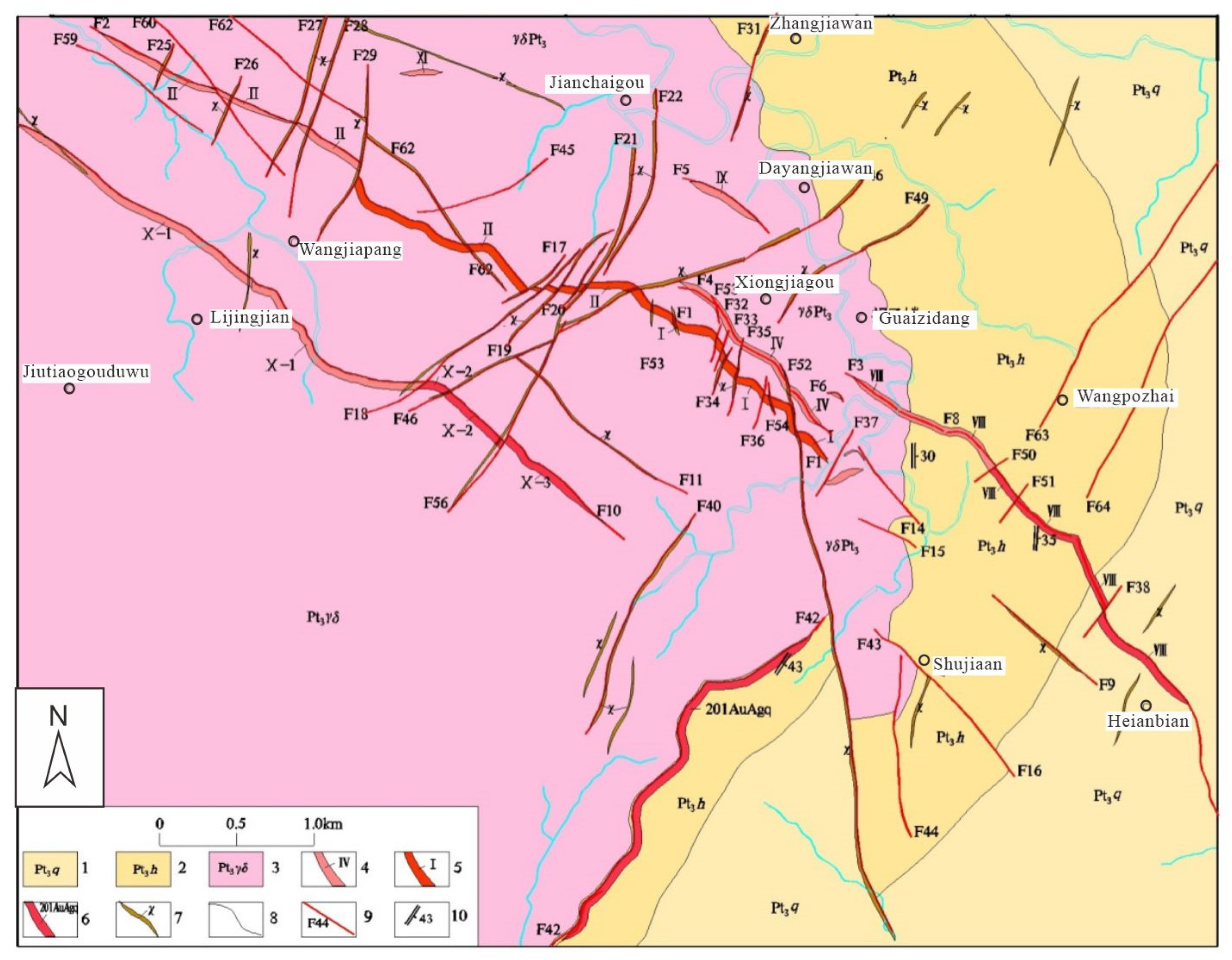
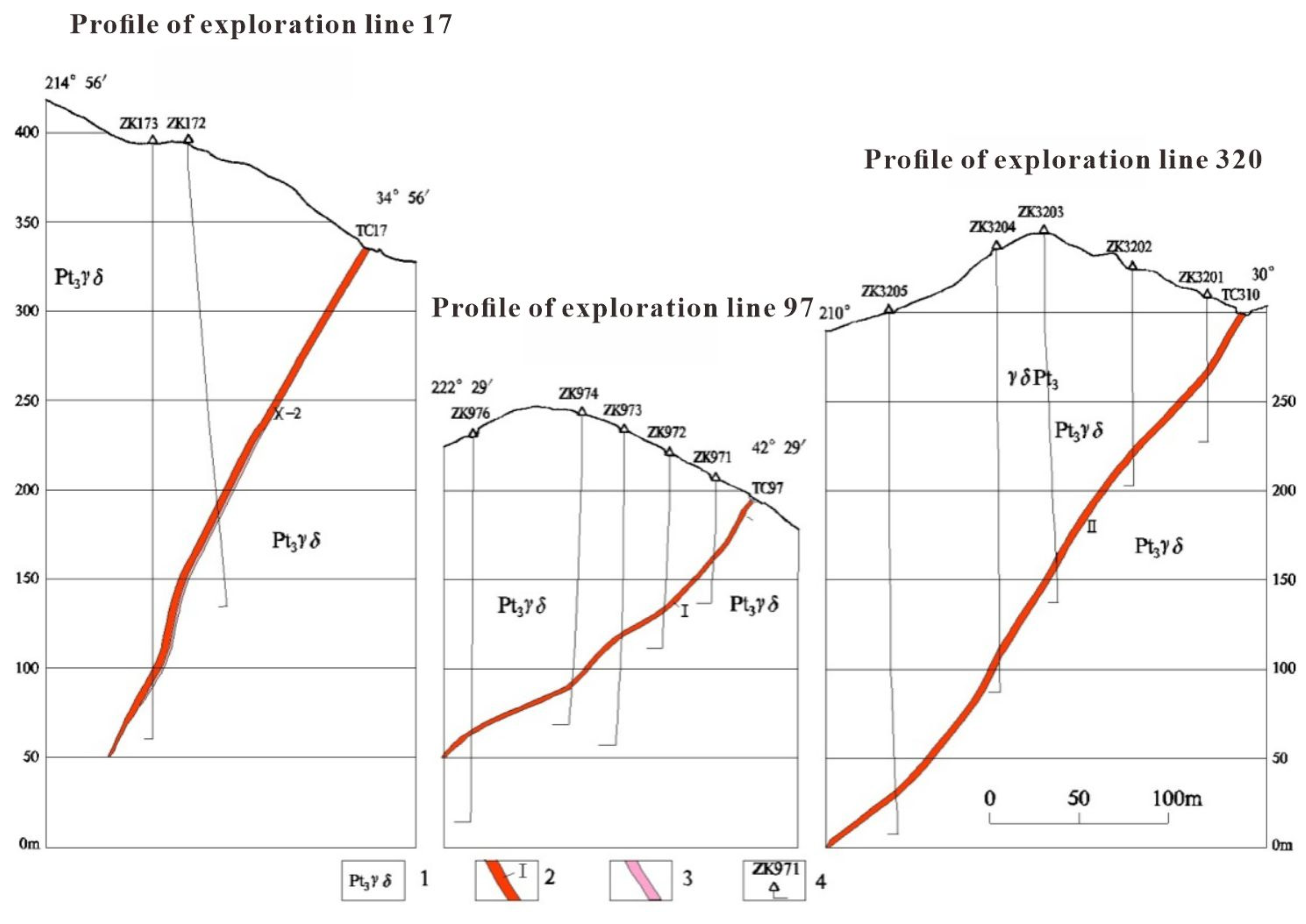

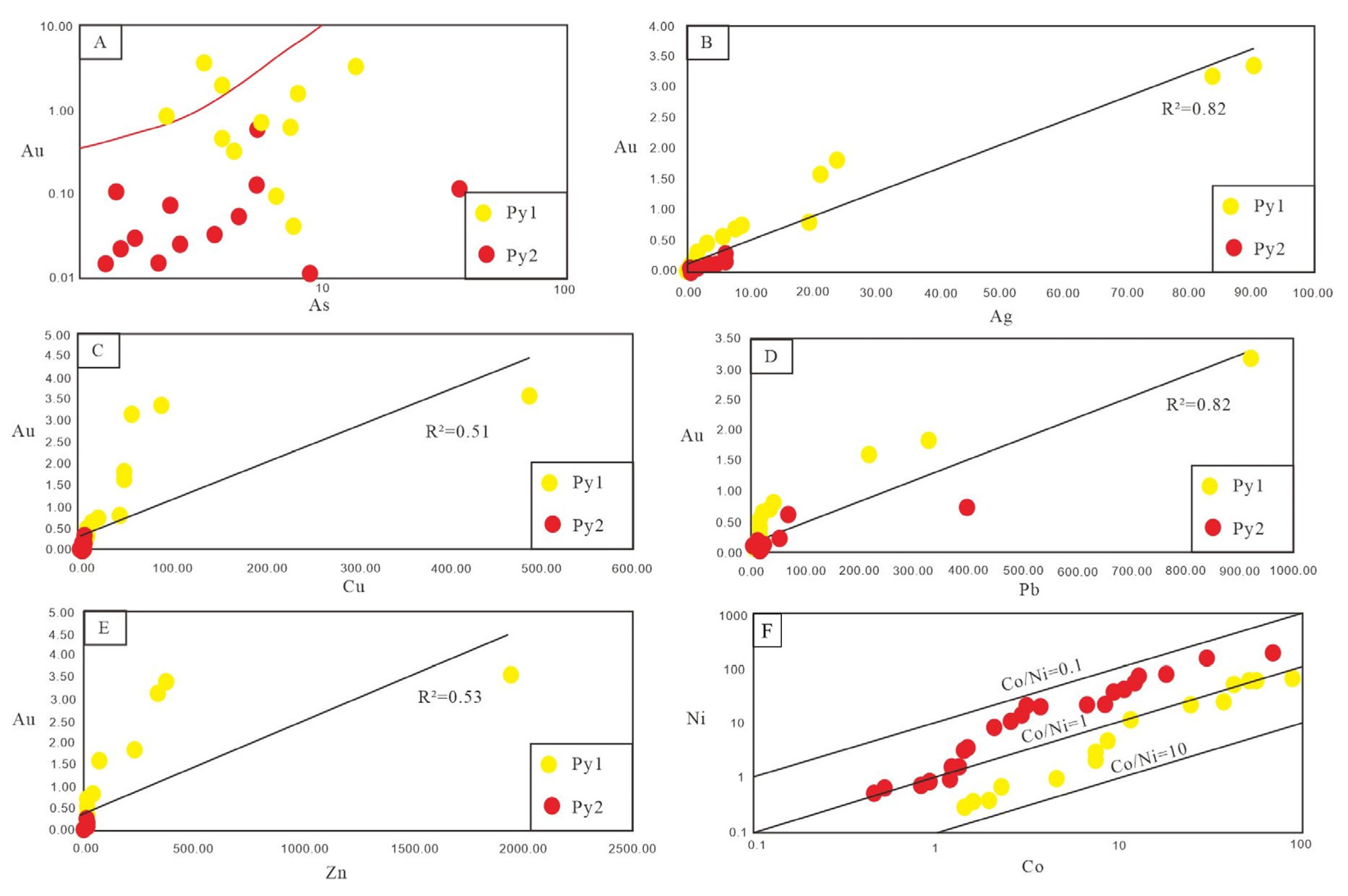
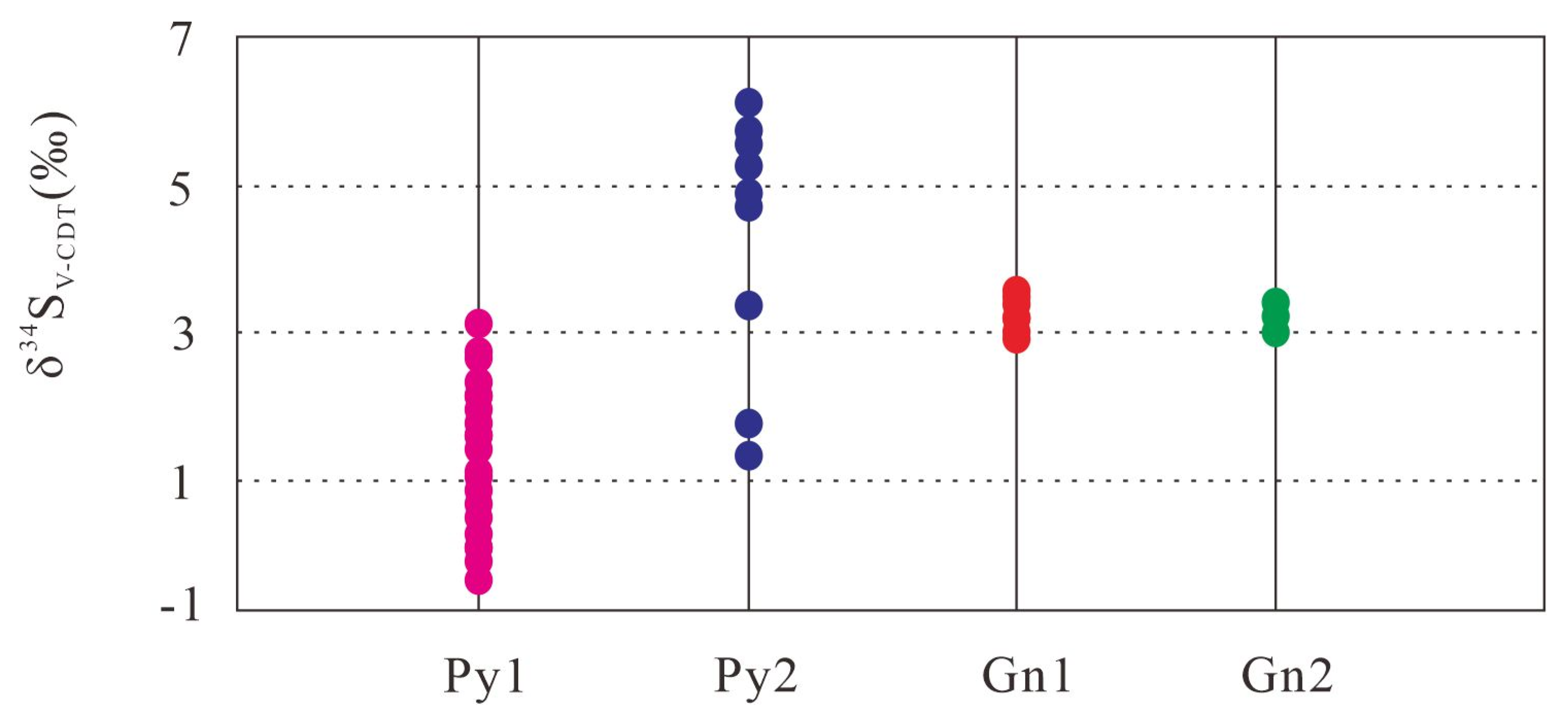
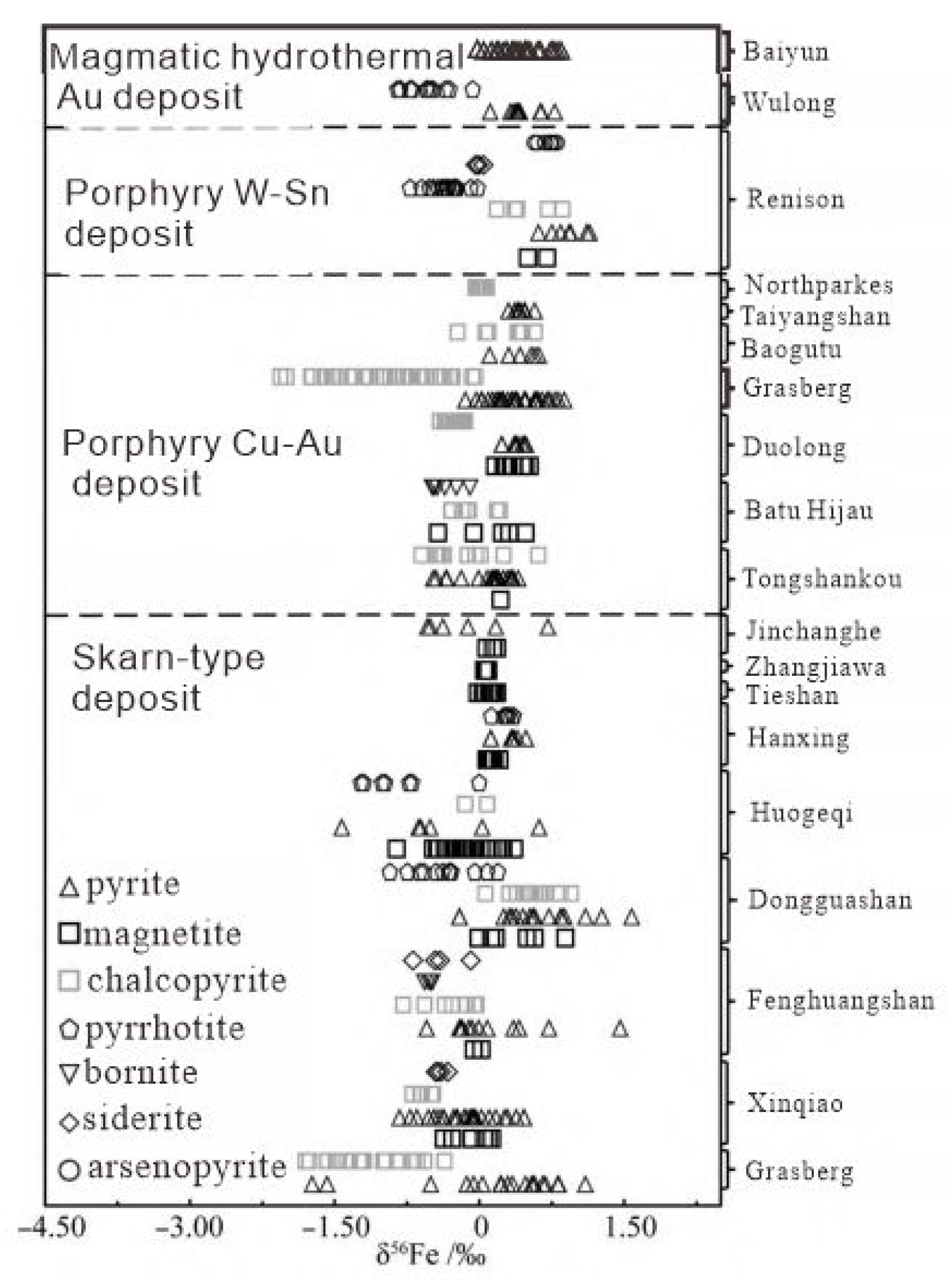
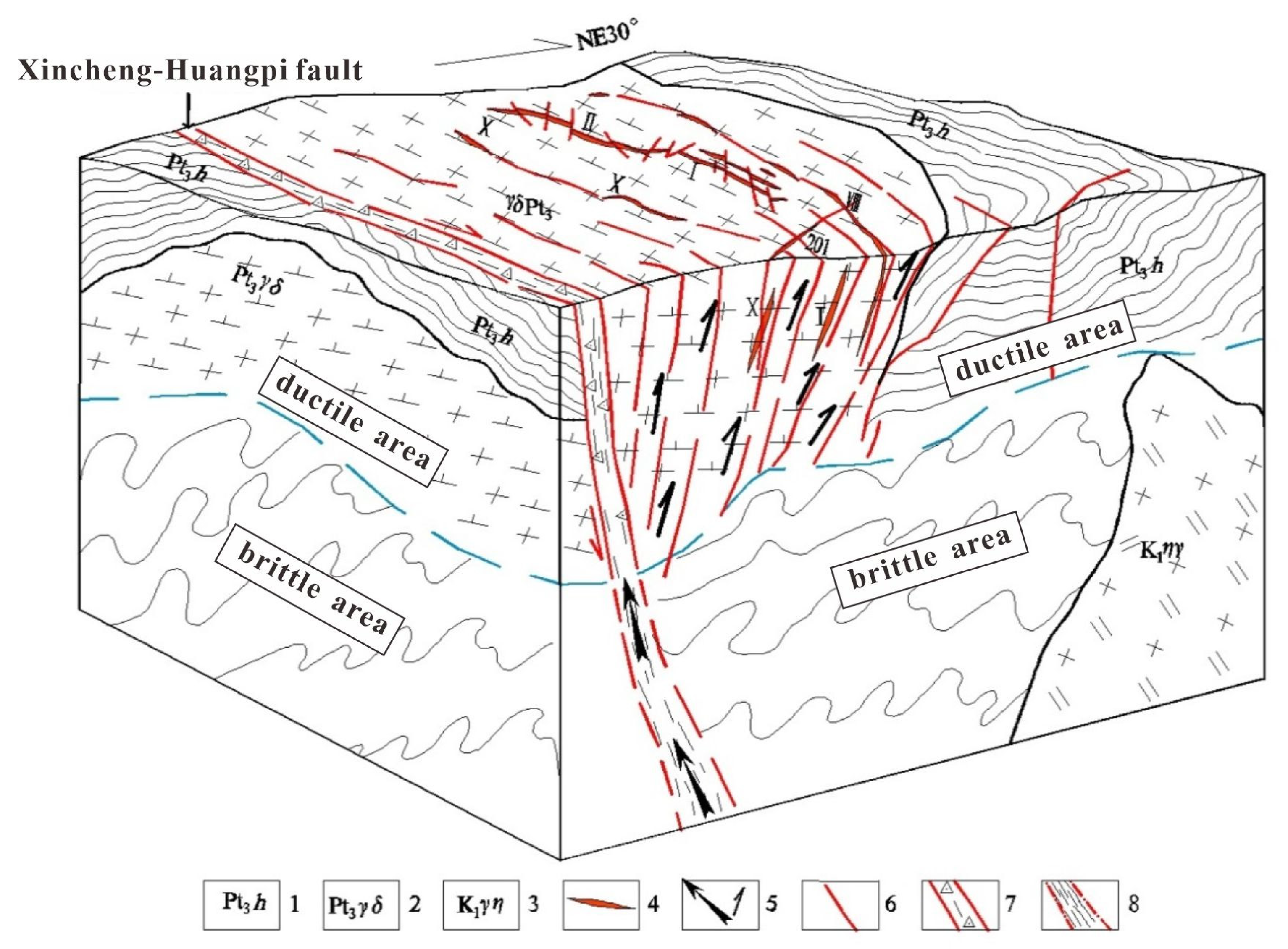
| Pyrite Type | Spot No. | Au | Co | Ni | Cu | Ti | Zn | As | Mo | Ag | Te | Bi | Pb |
|---|---|---|---|---|---|---|---|---|---|---|---|---|---|
| Py1 | BY-3-1-8 | 0.54 | 0.30 | 1.43 | 0.38 | 0.07 | 0.00 | 0.06 | 0.56 | 0.00 | 0.04 | 0.00 | 1.92 |
| BY-5-1-1 | 0.55 | 0.36 | 1.57 | 1.58 | 0.61 | 0.00 | 0.07 | 0.82 | 0.02 | 0.09 | 0.01 | 3.42 | |
| BY-5-1-3 | 0.97 | 0.39 | 1.91 | 2.38 | 0.76 | 0.00 | 0.07 | 0.83 | 0.43 | 0.10 | 0.03 | 4.57 | |
| BY-5-1-4 | 1.12 | 0.68 | 2.27 | 4.26 | 0.97 | 0.00 | 0.08 | 1.43 | 1.49 | 0.19 | 0.04 | 7.71 | |
| BY-5-1-12 | 1.85 | 0.97 | 4.50 | 4.36 | 0.98 | 2.29 | 0.09 | 1.54 | 1.65 | 0.31 | 0.08 | 13.22 | |
| BY-2-1-1 | 2.30 | 2.07 | 7.33 | 4.50 | 1.03 | 3.25 | 0.14 | 3.15 | 1.78 | 0.45 | 0.14 | 15.99 | |
| BY-2-1-2 | 2.36 | 2.78 | 7.33 | 7.72 | 1.39 | 3.85 | 0.15 | 5.71 | 2.74 | 0.56 | 0.27 | 16.15 | |
| BY-2-1-3 | 2.46 | 4.80 | 8.49 | 9.92 | 2.04 | 3.90 | 0.16 | 7.38 | 4.22 | 0.63 | 0.30 | 19.93 | |
| BY-2-1-4 | 2.61 | 11.65 | 11.20 | 13.09 | 3.47 | 4.35 | 0.18 | 7.44 | 8.06 | 0.71 | 0.55 | 31.99 | |
| BY-2-1-5 | 2.94 | 21.90 | 24.09 | 41.57 | 26.60 | 5.38 | 0.19 | 19.57 | 12.04 | 0.81 | 1.21 | 41.70 | |
| BY-2-1-6 | 3.04 | 24.34 | 36.46 | 45.93 | 61.24 | 6.49 | 0.22 | 21.13 | 15.34 | 1.60 | 1.24 | 216.07 | |
| BY-2-1-7 | 3.60 | 51.45 | 41.48 | 46.30 | 221.48 | 7.47 | 0.36 | 23.79 | 15.71 | 1.82 | 1.64 | 326.25 | |
| BY-1-1-12 | 3.94 | 57.13 | 50.70 | 55.86 | 330.71 | 7.54 | 10.02 | 83.48 | 36.81 | 3.18 | 4.08 | 921.45 | |
| BY-1-1-13 | 8.29 | 59.67 | 53.14 | 86.77 | 366.47 | 7.95 | 32.40 | 90.06 | 57.53 | 3.36 | 12.16 | 6379.76 | |
| BY-1-1-14 | 33.56 | 68.46 | 86.66 | 490.07 | 1938.54 | 13.86 | 142.31 | 698.28 | 491.68 | 3.57 | 126.20 | 74353.59 | |
| Py2 | BY-3-1-1 | 0.00 | 0.00 | 0.00 | 0.00 | 0.00 | 0.00 | 0.03 | 0.00 | 0.00 | 0.00 | 0.00 | 0.00 |
| BY-3-1-2 | 0.49 | 0.00 | 0.00 | 0.00 | 0.00 | 0.00 | 0.05 | 0.00 | 0.15 | 0.00 | 0.00 | 0.00 | |
| BY-3-1-3 | 0.58 | 0.00 | 0.00 | 0.00 | 0.00 | 0.00 | 0.07 | 0.00 | 0.22 | 0.00 | 0.00 | 0.03 | |
| BY-3-1-4 | 0.65 | 0.51 | 0.00 | 0.01 | 0.00 | 0.00 | 0.09 | 0.00 | 0.30 | 0.00 | 0.00 | 0.03 | |
| BY-3-1-5 | 0.74 | 0.54 | 0.46 | 0.02 | 0.00 | 0.00 | 0.09 | 0.00 | 0.37 | 0.00 | 0.00 | 0.04 | |
| BY-3-1-6 | 0.83 | 0.68 | 0.52 | 0.13 | 0.00 | 0.00 | 0.10 | 0.01 | 0.40 | 0.00 | 0.00 | 0.07 | |
| BY-3-1-7 | 0.92 | 0.79 | 0.83 | 0.20 | 0.18 | 0.00 | 0.11 | 0.01 | 0.56 | 0.00 | 0.00 | 0.08 | |
| BY-5-1-2 | 0.96 | 0.88 | 0.90 | 0.30 | 0.40 | 0.05 | 0.13 | 0.02 | 0.60 | 0.01 | 0.00 | 0.09 | |
| BY-5-1-5 | 1.03 | 1.01 | 1.16 | 0.41 | 0.41 | 0.86 | 0.13 | 0.02 | 0.63 | 0.01 | 0.00 | 0.10 | |
| BY-5-1-6 | 1.35 | 1.58 | 1.19 | 0.43 | 0.44 | 1.30 | 0.13 | 0.02 | 0.69 | 0.01 | 0.00 | 0.13 | |
| BY-5-1-7 | 1.37 | 1.64 | 1.30 | 0.45 | 0.45 | 1.44 | 0.13 | 0.03 | 0.69 | 0.01 | 0.00 | 0.13 | |
| BY-5-1-8 | 1.55 | 1.66 | 1.30 | 0.51 | 0.55 | 1.49 | 0.14 | 0.04 | 0.70 | 0.01 | 0.00 | 0.23 | |
| BY-5-1-9 | 1.55 | 3.39 | 1.44 | 0.55 | 0.61 | 1.69 | 0.14 | 0.04 | 0.80 | 0.02 | 0.01 | 0.41 | |
| BY-5-1-10 | 1.56 | 3.64 | 1.45 | 0.60 | 0.62 | 2.12 | 0.16 | 0.06 | 0.91 | 0.02 | 0.01 | 0.58 | |
| BY-5-1-11 | 1.86 | 8.80 | 2.04 | 0.87 | 0.62 | 2.38 | 0.16 | 0.12 | 1.05 | 0.02 | 0.02 | 1.85 | |
| BY-2-1-8 | 1.86 | 11.27 | 2.62 | 0.88 | 0.69 | 2.58 | 0.16 | 0.24 | 1.15 | 0.02 | 0.02 | 2.36 | |
| BY-1-1-1 | 1.95 | 14.65 | 2.92 | 1.65 | 0.70 | 3.63 | 0.17 | 0.32 | 1.41 | 0.03 | 0.02 | 2.38 | |
| BY-1-1-2 | 2.04 | 18.62 | 3.01 | 1.67 | 0.71 | 4.57 | 0.17 | 0.39 | 1.60 | 0.03 | 0.02 | 2.41 | |
| BY-1-1-3 | 2.25 | 20.78 | 3.71 | 1.78 | 0.71 | 5.30 | 0.18 | 0.40 | 1.70 | 0.03 | 0.03 | 3.44 | |
| BY-1-1-4 | 2.25 | 22.33 | 6.67 | 2.03 | 0.73 | 5.39 | 0.18 | 0.69 | 3.50 | 0.05 | 0.03 | 5.15 | |
| BY-1-1-5 | 2.26 | 23.13 | 8.38 | 2.55 | 0.74 | 5.84 | 0.18 | 0.88 | 4.42 | 0.07 | 0.03 | 10.77 | |
| BY-1-1-6 | 2.29 | 36.99 | 9.28 | 3.33 | 0.77 | 7.85 | 0.18 | 0.94 | 5.78 | 0.08 | 0.04 | 15.79 | |
| BY-1-1-7 | 2.34 | 41.10 | 10.49 | 3.38 | 0.79 | 8.71 | 0.18 | 1.08 | 6.12 | 0.09 | 0.09 | 19.78 | |
| BY-1-1-8 | 2.55 | 56.15 | 12.16 | 4.30 | 0.90 | 8.87 | 0.19 | 3.27 | 6.43 | 0.11 | 0.13 | 21.82 | |
| BY-1-1-9 | 2.62 | 70.03 | 12.46 | 5.37 | 0.99 | 9.05 | 0.21 | 3.28 | 10.05 | 0.12 | 0.17 | 22.15 | |
| BY-1-1-10 | 2.68 | 78.42 | 17.72 | 5.43 | 1.04 | 9.99 | 0.21 | 5.43 | 11.35 | 0.12 | 0.18 | 24.44 | |
| BY-1-1-11 | 3.03 | 78.68 | 18.01 | 5.47 | 1.07 | 18.62 | 0.22 | 5.76 | 13.04 | 0.25 | 0.21 | 50.61 | |
| BY-1-1-15 | 3.84 | 160.83 | 29.51 | 8.70 | 1.14 | 36.80 | 0.24 | 6.90 | 16.59 | 0.64 | 0.46 | 67.65 |
| Types | Stages | Spot No. | δ34SV−CDT (‰) |
|---|---|---|---|
| Py1 | Main ore stage | BY-2-1-PY-1 | 0.79 |
| BY-2-1-PY-2 | 2.07 | ||
| BY-2-1-PY-3 | 0.41 | ||
| BY-2-1-PY-4 | −0.23 | ||
| BY-2-1-PY-5 | 2.19 | ||
| BY-2-1-PY-6 | 0.05 | ||
| BY-2-1-PY-7 | 1.81 | ||
| BY-2-1-PY-8 | 0.63 | ||
| BY-2-1-PY-9 | −0.16 | ||
| BY-1-1-PY-10 | 1.42 | ||
| BY-5-1-PY-11 | 1.16 | ||
| BY-5-1-PY-12 | 0.92 | ||
| BY-1-1-PY-4 | 0.15 | ||
| BY-1-1-PY-5 | 2.73 | ||
| BY-1-1-PY-6 | 2.79 | ||
| BY-1-1-PY-7 | 2.42 | ||
| BY-1-1-PY-8 | 1.06 | ||
| BY-1-1-PY-9 | 1.89 | ||
| BY-1-1-PY-10 | 1.57 | ||
| BY-1-1-PY-11 | 1.70 | ||
| BY-1-1-PY-12 | 3.04 | ||
| BY-1-1-PY-13 | 1.91 | ||
| BY-1-1-PY-14 | 0.94 | ||
| BY-1-1-PY-15 | 1.79 | ||
| BY-1-1-PY-16 | 1.26 | ||
| Py2 | Late ore stage | BY-1-1-PY-1 | 5.89 |
| BY-1-1-PY-2 | 4.80 | ||
| BY-1-1-PY-3 | 5.30 | ||
| BY-1-1-PY-4 | 6.09 | ||
| BY-1-1-PY-5 | 1.27 | ||
| BY-1-1-PY-6 | 3.51 | ||
| BY-1-1-PY-7 | 1.80 | ||
| BY-1-1-PY-8 | 5.45 | ||
| BY-1-1-PY-9 | 4.93 | ||
| Gn1 | Main ore stage | BY-1-1-GN-1 | 2.97 |
| BY-1-1-GN-2 | 3.31 | ||
| BY-1-1-GN-3 | 3.22 | ||
| BY-1-1-GN-4 | 3.08 | ||
| BY-1-1-GN-5 | 3.24 | ||
| BY-1-1-GN-6 | 3.34 | ||
| BY-1-1-GN-7 | 3.17 | ||
| BY-1-1-GN-8 | 3.47 | ||
| BY-1-1-GN-9 | 3.08 | ||
| BY-1-1-GN-10 | 3.16 | ||
| BY-1-1-GN-11 | 3.15 | ||
| BY-1-1-GN-12 | 3.30 | ||
| Gn2 | Main ore stage | BY-1-1-GN-13 | 3.16 |
| BY-1-1-GN-14 | 3.16 | ||
| BY-1-1-GN-15 | 3.30 | ||
| BY-1-1-GN-16 | 3.00 |
| Types | Stages | Spot No. | δ56FeIRMM014‰ |
|---|---|---|---|
| Py1 | Main ore stage | BY-1-1-1 | 0.23 |
| BY-1-1-2 | 0.18 | ||
| BY-1-1-3 | −0.05 | ||
| BY-1-1-4 | 0.38 | ||
| BY-5-1-1 | 0.45 | ||
| BY-5-1-2 | 0.43 | ||
| BY-5-1-3 | 0.05 | ||
| BY-5-1-4 | 0.31 | ||
| BY-5-1-5 | 0.37 | ||
| BY-5-1-6 | 0.34 | ||
| BY-2-1-1 | 0.33 | ||
| BY-2-1-2 | 0.47 | ||
| BY-2-1-3 | 0.33 | ||
| BY-2-1-4 | 0.36 | ||
| BY-2-1-5 | 0.21 | ||
| BY-2-1-6 | 0.33 | ||
| BY-2-1-7 | 0.36 | ||
| BY-3-1-1 | 0.50 | ||
| BY-3-1-2 | 0.26 | ||
| BY-3-1-3 | 0.11 | ||
| BY-3-1-4 | 0.21 | ||
| BY-1-1-1 | 0.23 | ||
| Py2 | Late ore stage | BY-1-1-5 | 0.42 |
| BY-1-1-6 | 0.82 | ||
| BY-1-1-7 | 0.60 | ||
| BY-1-1-8 | 0.41 | ||
| BY-1-1-9 | 0.27 | ||
| BY-1-1-10 | 0.27 | ||
| BY-1-1-11 | 0.50 | ||
| BY-1-1-12 | 0.49 | ||
| BY-1-1-13 | 0.45 | ||
| BY-1-1-14 | 0.47 | ||
| BY-5-1-7 | 0.61 | ||
| BY-5-1-8 | 0.59 | ||
| BY-5-1-9 | 0.57 | ||
| BY-5-1-10 | 0.52 | ||
| BY-5-1-11 | 0.59 | ||
| BY-5-1-12 | 0.45 | ||
| BY-2-1-8 | 0.66 | ||
| BY-2-1-9 | 0.65 | ||
| BY-3-1-5 | 0.41 | ||
| BY-3-1-6 | 0.36 | ||
| BY-3-1-7 | 0.25 |
Disclaimer/Publisher’s Note: The statements, opinions and data contained in all publications are solely those of the individual author(s) and contributor(s) and not of MDPI and/or the editor(s). MDPI and/or the editor(s) disclaim responsibility for any injury to people or property resulting from any ideas, methods, instructions or products referred to in the content. |
© 2024 by the authors. Licensee MDPI, Basel, Switzerland. This article is an open access article distributed under the terms and conditions of the Creative Commons Attribution (CC BY) license (https://creativecommons.org/licenses/by/4.0/).
Share and Cite
Song, W.; Liu, J.; Zou, Y.; Liu, X.; Long, T.; Zhu, J.; Fu, S.; Chen, S.; Xiong, Y.; Zhou, R.; et al. Genesis of the Baiyun Gold Deposit in Northeast Hubei Province, China: Insights from In Situ Trace Elements and S-Fe Isotopes of Sulfide. Minerals 2024, 14, 517. https://doi.org/10.3390/min14050517
Song W, Liu J, Zou Y, Liu X, Long T, Zhu J, Fu S, Chen S, Xiong Y, Zhou R, et al. Genesis of the Baiyun Gold Deposit in Northeast Hubei Province, China: Insights from In Situ Trace Elements and S-Fe Isotopes of Sulfide. Minerals. 2024; 14(5):517. https://doi.org/10.3390/min14050517
Chicago/Turabian StyleSong, Weifang, Jianzhong Liu, Yuanbing Zou, Xingping Liu, Taocheng Long, Jiandong Zhu, Shengbo Fu, Song Chen, Yangfu Xiong, Runjie Zhou, and et al. 2024. "Genesis of the Baiyun Gold Deposit in Northeast Hubei Province, China: Insights from In Situ Trace Elements and S-Fe Isotopes of Sulfide" Minerals 14, no. 5: 517. https://doi.org/10.3390/min14050517
APA StyleSong, W., Liu, J., Zou, Y., Liu, X., Long, T., Zhu, J., Fu, S., Chen, S., Xiong, Y., Zhou, R., You, J., Zhou, X., Yang, Z., & Fang, J. (2024). Genesis of the Baiyun Gold Deposit in Northeast Hubei Province, China: Insights from In Situ Trace Elements and S-Fe Isotopes of Sulfide. Minerals, 14(5), 517. https://doi.org/10.3390/min14050517





